MBA Project: Food Truck Business Development Proposal, Malaysia
VerifiedAdded on 2023/06/04
|66
|20491
|74
Project
AI Summary
This document is a business development proposal evaluating the feasibility of a food truck business in the Klang Valley, Malaysia. It begins by describing the mobile food industry and the growing demand for affordable, hygienic food options. The proposal highlights the lack of competition and the time-saving benefits of food trucks. It further assesses the feasibility of a new business serving local Malaysian dishes in the Klang Valley, considering market, marketing, financial, and operational aspects. The document includes data analysis with qualitative and quantitative methods, a conclusion summarizing the research, and recommendations for improving performance and ensuring business success. It also features a marketing plan, organizational plan, human capital plan, financial planning with projected statements, key performance indicators, an implementation schedule with a Gantt chart, critical success factors, and risk mitigation strategies.
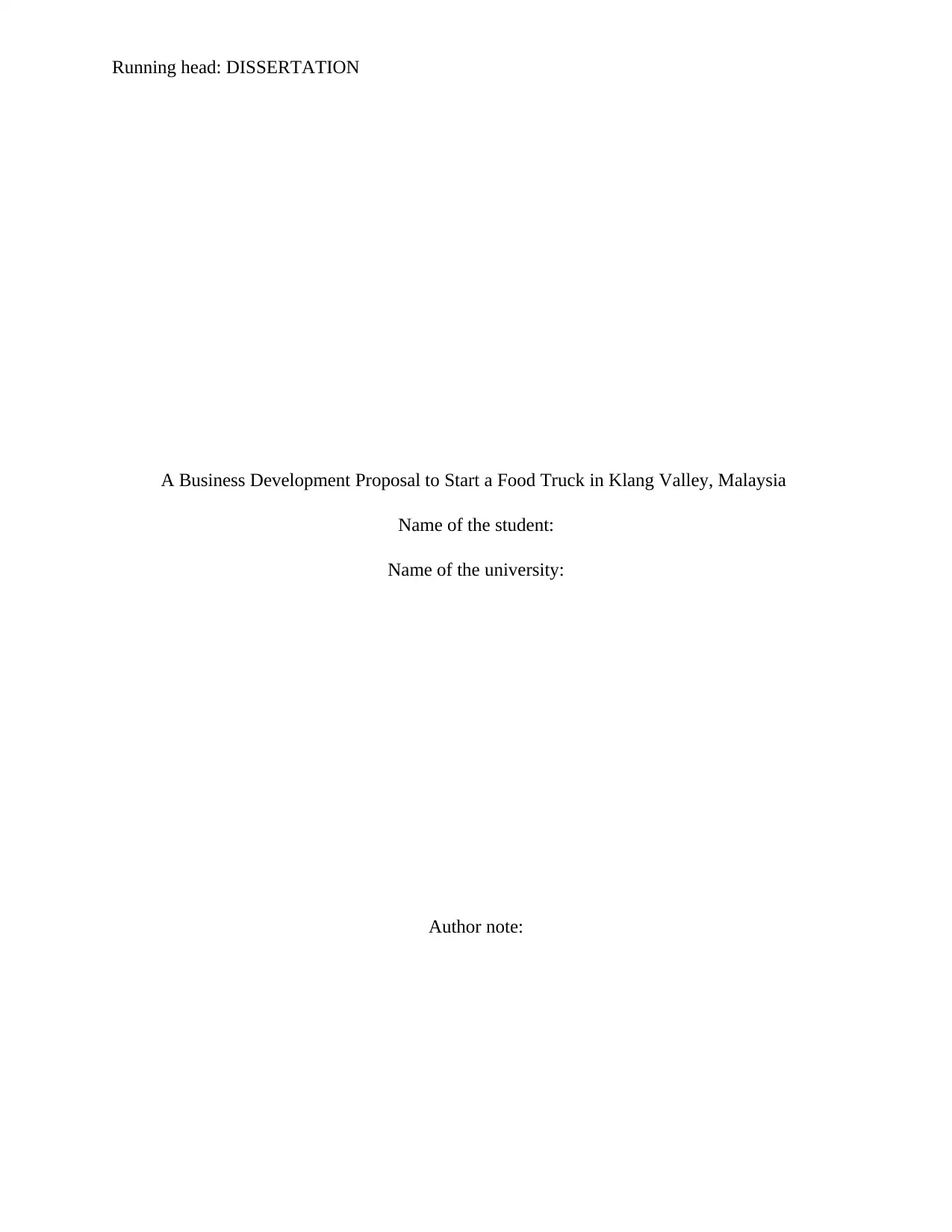
Running head: DISSERTATION
A Business Development Proposal to Start a Food Truck in Klang Valley, Malaysia
Name of the student:
Name of the university:
Author note:
A Business Development Proposal to Start a Food Truck in Klang Valley, Malaysia
Name of the student:
Name of the university:
Author note:
Paraphrase This Document
Need a fresh take? Get an instant paraphrase of this document with our AI Paraphraser
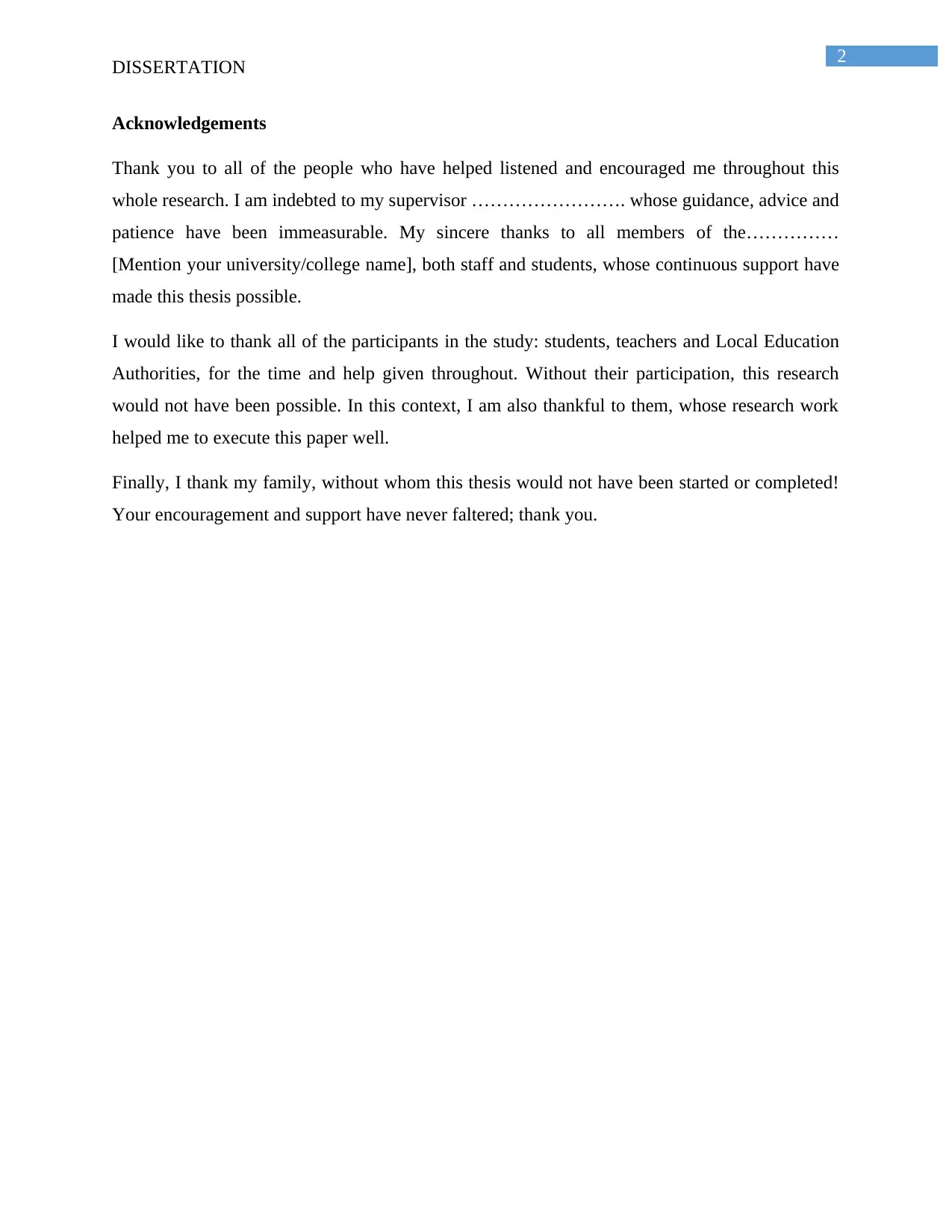
2
DISSERTATION
Acknowledgements
Thank you to all of the people who have helped listened and encouraged me throughout this
whole research. I am indebted to my supervisor ……………………. whose guidance, advice and
patience have been immeasurable. My sincere thanks to all members of the……………
[Mention your university/college name], both staff and students, whose continuous support have
made this thesis possible.
I would like to thank all of the participants in the study: students, teachers and Local Education
Authorities, for the time and help given throughout. Without their participation, this research
would not have been possible. In this context, I am also thankful to them, whose research work
helped me to execute this paper well.
Finally, I thank my family, without whom this thesis would not have been started or completed!
Your encouragement and support have never faltered; thank you.
DISSERTATION
Acknowledgements
Thank you to all of the people who have helped listened and encouraged me throughout this
whole research. I am indebted to my supervisor ……………………. whose guidance, advice and
patience have been immeasurable. My sincere thanks to all members of the……………
[Mention your university/college name], both staff and students, whose continuous support have
made this thesis possible.
I would like to thank all of the participants in the study: students, teachers and Local Education
Authorities, for the time and help given throughout. Without their participation, this research
would not have been possible. In this context, I am also thankful to them, whose research work
helped me to execute this paper well.
Finally, I thank my family, without whom this thesis would not have been started or completed!
Your encouragement and support have never faltered; thank you.
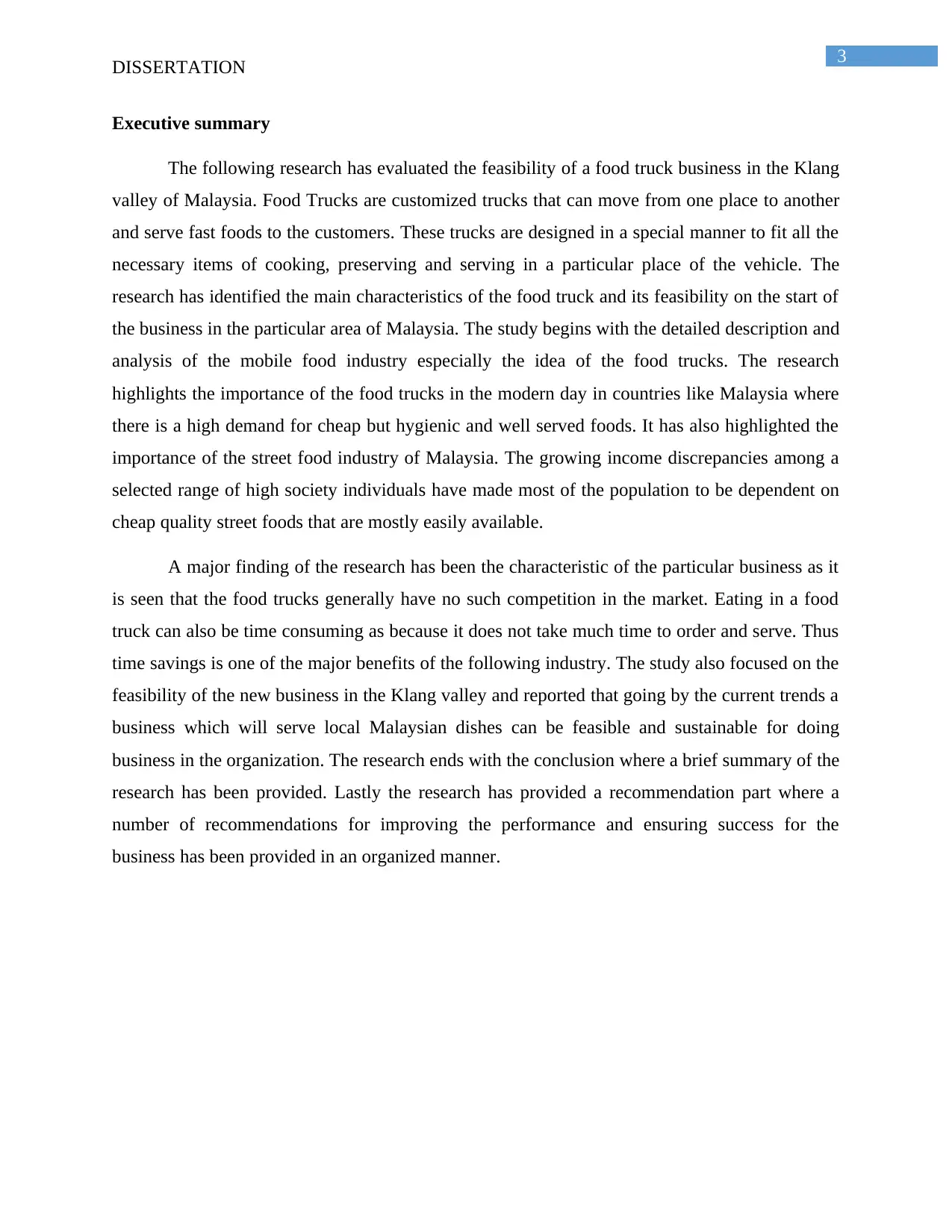
3
DISSERTATION
Executive summary
The following research has evaluated the feasibility of a food truck business in the Klang
valley of Malaysia. Food Trucks are customized trucks that can move from one place to another
and serve fast foods to the customers. These trucks are designed in a special manner to fit all the
necessary items of cooking, preserving and serving in a particular place of the vehicle. The
research has identified the main characteristics of the food truck and its feasibility on the start of
the business in the particular area of Malaysia. The study begins with the detailed description and
analysis of the mobile food industry especially the idea of the food trucks. The research
highlights the importance of the food trucks in the modern day in countries like Malaysia where
there is a high demand for cheap but hygienic and well served foods. It has also highlighted the
importance of the street food industry of Malaysia. The growing income discrepancies among a
selected range of high society individuals have made most of the population to be dependent on
cheap quality street foods that are mostly easily available.
A major finding of the research has been the characteristic of the particular business as it
is seen that the food trucks generally have no such competition in the market. Eating in a food
truck can also be time consuming as because it does not take much time to order and serve. Thus
time savings is one of the major benefits of the following industry. The study also focused on the
feasibility of the new business in the Klang valley and reported that going by the current trends a
business which will serve local Malaysian dishes can be feasible and sustainable for doing
business in the organization. The research ends with the conclusion where a brief summary of the
research has been provided. Lastly the research has provided a recommendation part where a
number of recommendations for improving the performance and ensuring success for the
business has been provided in an organized manner.
DISSERTATION
Executive summary
The following research has evaluated the feasibility of a food truck business in the Klang
valley of Malaysia. Food Trucks are customized trucks that can move from one place to another
and serve fast foods to the customers. These trucks are designed in a special manner to fit all the
necessary items of cooking, preserving and serving in a particular place of the vehicle. The
research has identified the main characteristics of the food truck and its feasibility on the start of
the business in the particular area of Malaysia. The study begins with the detailed description and
analysis of the mobile food industry especially the idea of the food trucks. The research
highlights the importance of the food trucks in the modern day in countries like Malaysia where
there is a high demand for cheap but hygienic and well served foods. It has also highlighted the
importance of the street food industry of Malaysia. The growing income discrepancies among a
selected range of high society individuals have made most of the population to be dependent on
cheap quality street foods that are mostly easily available.
A major finding of the research has been the characteristic of the particular business as it
is seen that the food trucks generally have no such competition in the market. Eating in a food
truck can also be time consuming as because it does not take much time to order and serve. Thus
time savings is one of the major benefits of the following industry. The study also focused on the
feasibility of the new business in the Klang valley and reported that going by the current trends a
business which will serve local Malaysian dishes can be feasible and sustainable for doing
business in the organization. The research ends with the conclusion where a brief summary of the
research has been provided. Lastly the research has provided a recommendation part where a
number of recommendations for improving the performance and ensuring success for the
business has been provided in an organized manner.
⊘ This is a preview!⊘
Do you want full access?
Subscribe today to unlock all pages.

Trusted by 1+ million students worldwide

4
DISSERTATION
Approval Page
DISSERTATION
Approval Page
Paraphrase This Document
Need a fresh take? Get an instant paraphrase of this document with our AI Paraphraser
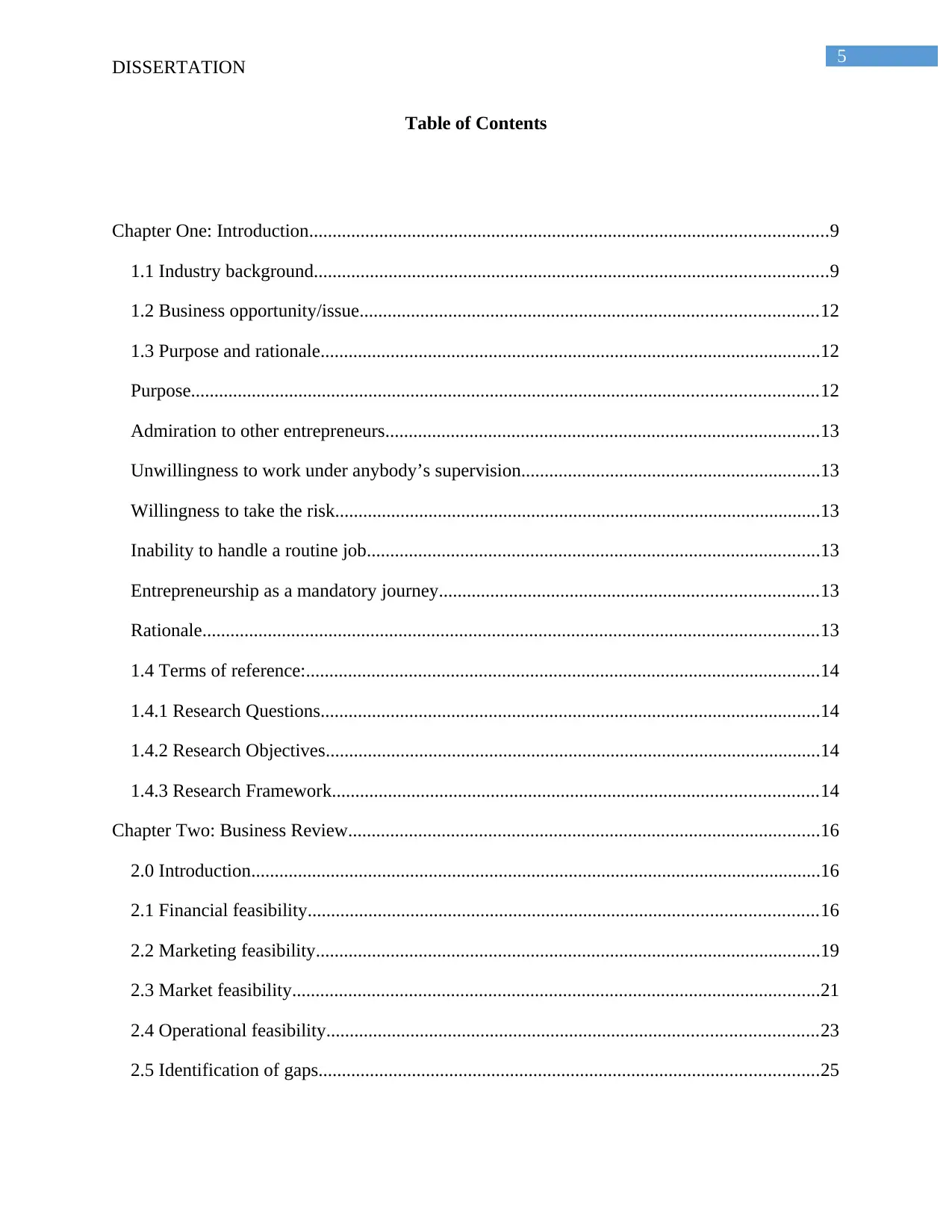
5
DISSERTATION
Table of Contents
Chapter One: Introduction...............................................................................................................9
1.1 Industry background..............................................................................................................9
1.2 Business opportunity/issue..................................................................................................12
1.3 Purpose and rationale...........................................................................................................12
Purpose......................................................................................................................................12
Admiration to other entrepreneurs.............................................................................................13
Unwillingness to work under anybody’s supervision................................................................13
Willingness to take the risk........................................................................................................13
Inability to handle a routine job.................................................................................................13
Entrepreneurship as a mandatory journey.................................................................................13
Rationale....................................................................................................................................13
1.4 Terms of reference:..............................................................................................................14
1.4.1 Research Questions...........................................................................................................14
1.4.2 Research Objectives..........................................................................................................14
1.4.3 Research Framework........................................................................................................14
Chapter Two: Business Review.....................................................................................................16
2.0 Introduction..........................................................................................................................16
2.1 Financial feasibility.............................................................................................................16
2.2 Marketing feasibility............................................................................................................19
2.3 Market feasibility.................................................................................................................21
2.4 Operational feasibility.........................................................................................................23
2.5 Identification of gaps...........................................................................................................25
DISSERTATION
Table of Contents
Chapter One: Introduction...............................................................................................................9
1.1 Industry background..............................................................................................................9
1.2 Business opportunity/issue..................................................................................................12
1.3 Purpose and rationale...........................................................................................................12
Purpose......................................................................................................................................12
Admiration to other entrepreneurs.............................................................................................13
Unwillingness to work under anybody’s supervision................................................................13
Willingness to take the risk........................................................................................................13
Inability to handle a routine job.................................................................................................13
Entrepreneurship as a mandatory journey.................................................................................13
Rationale....................................................................................................................................13
1.4 Terms of reference:..............................................................................................................14
1.4.1 Research Questions...........................................................................................................14
1.4.2 Research Objectives..........................................................................................................14
1.4.3 Research Framework........................................................................................................14
Chapter Two: Business Review.....................................................................................................16
2.0 Introduction..........................................................................................................................16
2.1 Financial feasibility.............................................................................................................16
2.2 Marketing feasibility............................................................................................................19
2.3 Market feasibility.................................................................................................................21
2.4 Operational feasibility.........................................................................................................23
2.5 Identification of gaps...........................................................................................................25
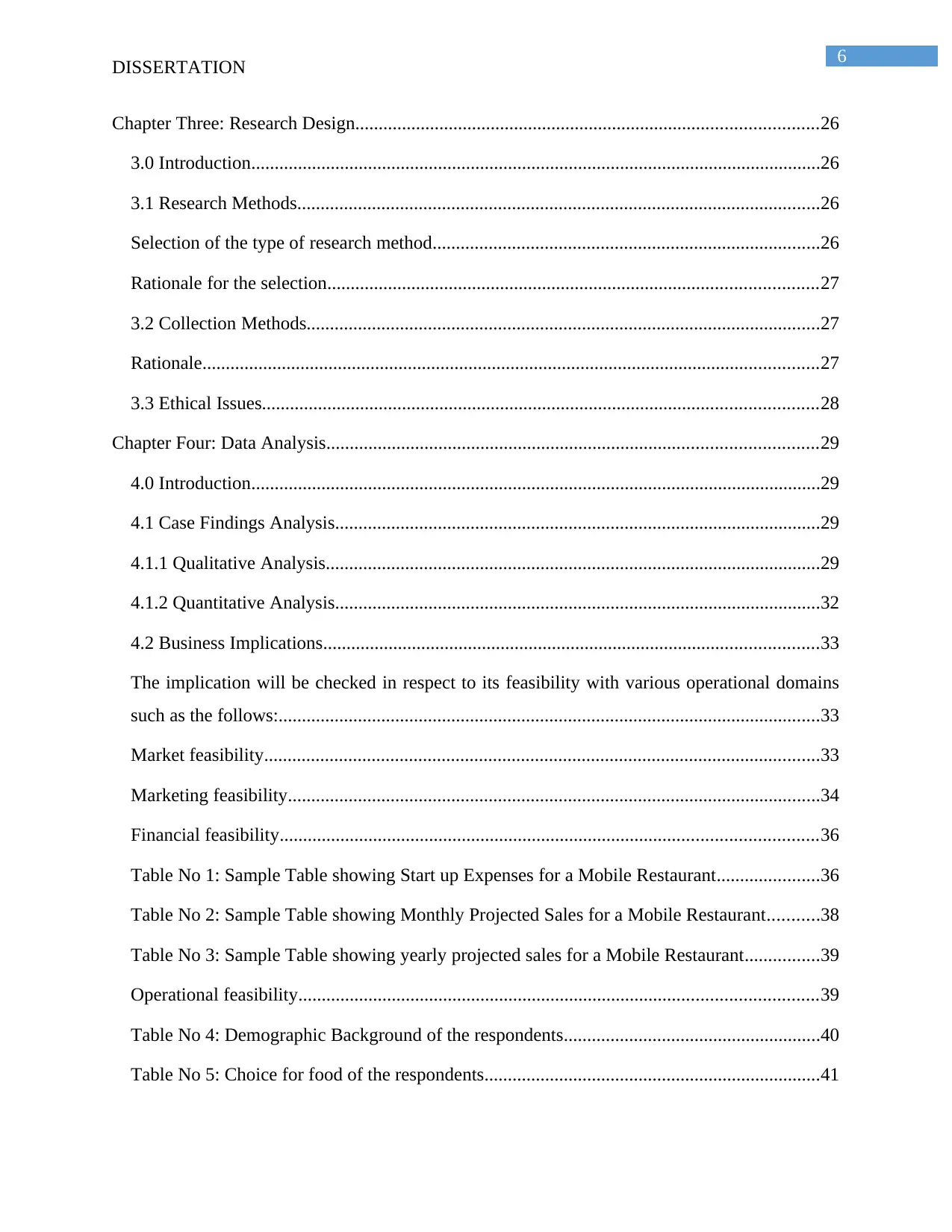
6
DISSERTATION
Chapter Three: Research Design...................................................................................................26
3.0 Introduction..........................................................................................................................26
3.1 Research Methods................................................................................................................26
Selection of the type of research method...................................................................................26
Rationale for the selection.........................................................................................................27
3.2 Collection Methods..............................................................................................................27
Rationale....................................................................................................................................27
3.3 Ethical Issues.......................................................................................................................28
Chapter Four: Data Analysis.........................................................................................................29
4.0 Introduction..........................................................................................................................29
4.1 Case Findings Analysis........................................................................................................29
4.1.1 Qualitative Analysis..........................................................................................................29
4.1.2 Quantitative Analysis........................................................................................................32
4.2 Business Implications..........................................................................................................33
The implication will be checked in respect to its feasibility with various operational domains
such as the follows:....................................................................................................................33
Market feasibility.......................................................................................................................33
Marketing feasibility..................................................................................................................34
Financial feasibility...................................................................................................................36
Table No 1: Sample Table showing Start up Expenses for a Mobile Restaurant......................36
Table No 2: Sample Table showing Monthly Projected Sales for a Mobile Restaurant...........38
Table No 3: Sample Table showing yearly projected sales for a Mobile Restaurant................39
Operational feasibility...............................................................................................................39
Table No 4: Demographic Background of the respondents.......................................................40
Table No 5: Choice for food of the respondents........................................................................41
DISSERTATION
Chapter Three: Research Design...................................................................................................26
3.0 Introduction..........................................................................................................................26
3.1 Research Methods................................................................................................................26
Selection of the type of research method...................................................................................26
Rationale for the selection.........................................................................................................27
3.2 Collection Methods..............................................................................................................27
Rationale....................................................................................................................................27
3.3 Ethical Issues.......................................................................................................................28
Chapter Four: Data Analysis.........................................................................................................29
4.0 Introduction..........................................................................................................................29
4.1 Case Findings Analysis........................................................................................................29
4.1.1 Qualitative Analysis..........................................................................................................29
4.1.2 Quantitative Analysis........................................................................................................32
4.2 Business Implications..........................................................................................................33
The implication will be checked in respect to its feasibility with various operational domains
such as the follows:....................................................................................................................33
Market feasibility.......................................................................................................................33
Marketing feasibility..................................................................................................................34
Financial feasibility...................................................................................................................36
Table No 1: Sample Table showing Start up Expenses for a Mobile Restaurant......................36
Table No 2: Sample Table showing Monthly Projected Sales for a Mobile Restaurant...........38
Table No 3: Sample Table showing yearly projected sales for a Mobile Restaurant................39
Operational feasibility...............................................................................................................39
Table No 4: Demographic Background of the respondents.......................................................40
Table No 5: Choice for food of the respondents........................................................................41
⊘ This is a preview!⊘
Do you want full access?
Subscribe today to unlock all pages.

Trusted by 1+ million students worldwide
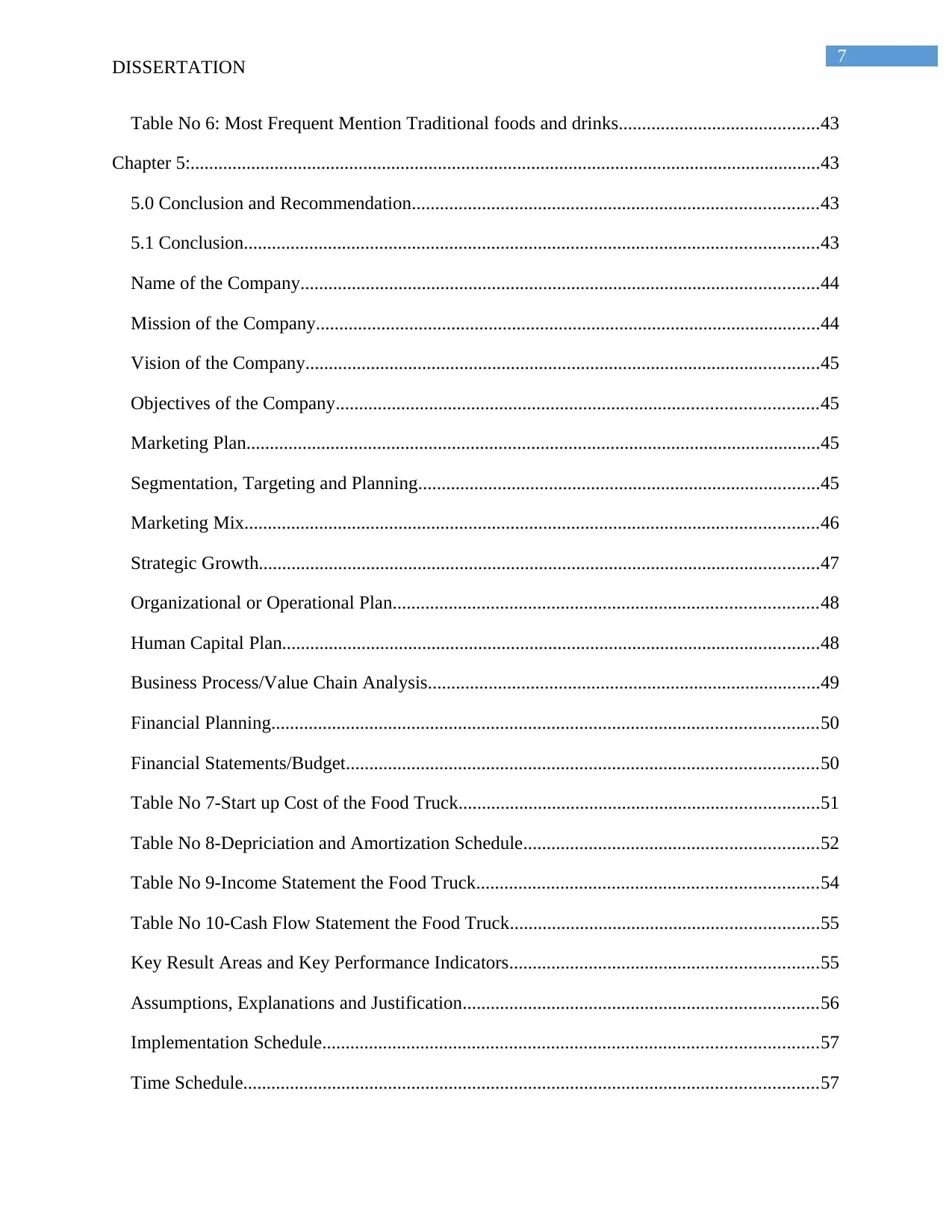
7
DISSERTATION
Table No 6: Most Frequent Mention Traditional foods and drinks...........................................43
Chapter 5:.......................................................................................................................................43
5.0 Conclusion and Recommendation.......................................................................................43
5.1 Conclusion...........................................................................................................................43
Name of the Company...............................................................................................................44
Mission of the Company............................................................................................................44
Vision of the Company..............................................................................................................45
Objectives of the Company.......................................................................................................45
Marketing Plan...........................................................................................................................45
Segmentation, Targeting and Planning......................................................................................45
Marketing Mix...........................................................................................................................46
Strategic Growth........................................................................................................................47
Organizational or Operational Plan...........................................................................................48
Human Capital Plan...................................................................................................................48
Business Process/Value Chain Analysis....................................................................................49
Financial Planning.....................................................................................................................50
Financial Statements/Budget.....................................................................................................50
Table No 7-Start up Cost of the Food Truck.............................................................................51
Table No 8-Depriciation and Amortization Schedule...............................................................52
Table No 9-Income Statement the Food Truck.........................................................................54
Table No 10-Cash Flow Statement the Food Truck..................................................................55
Key Result Areas and Key Performance Indicators..................................................................55
Assumptions, Explanations and Justification............................................................................56
Implementation Schedule..........................................................................................................57
Time Schedule...........................................................................................................................57
DISSERTATION
Table No 6: Most Frequent Mention Traditional foods and drinks...........................................43
Chapter 5:.......................................................................................................................................43
5.0 Conclusion and Recommendation.......................................................................................43
5.1 Conclusion...........................................................................................................................43
Name of the Company...............................................................................................................44
Mission of the Company............................................................................................................44
Vision of the Company..............................................................................................................45
Objectives of the Company.......................................................................................................45
Marketing Plan...........................................................................................................................45
Segmentation, Targeting and Planning......................................................................................45
Marketing Mix...........................................................................................................................46
Strategic Growth........................................................................................................................47
Organizational or Operational Plan...........................................................................................48
Human Capital Plan...................................................................................................................48
Business Process/Value Chain Analysis....................................................................................49
Financial Planning.....................................................................................................................50
Financial Statements/Budget.....................................................................................................50
Table No 7-Start up Cost of the Food Truck.............................................................................51
Table No 8-Depriciation and Amortization Schedule...............................................................52
Table No 9-Income Statement the Food Truck.........................................................................54
Table No 10-Cash Flow Statement the Food Truck..................................................................55
Key Result Areas and Key Performance Indicators..................................................................55
Assumptions, Explanations and Justification............................................................................56
Implementation Schedule..........................................................................................................57
Time Schedule...........................................................................................................................57
Paraphrase This Document
Need a fresh take? Get an instant paraphrase of this document with our AI Paraphraser
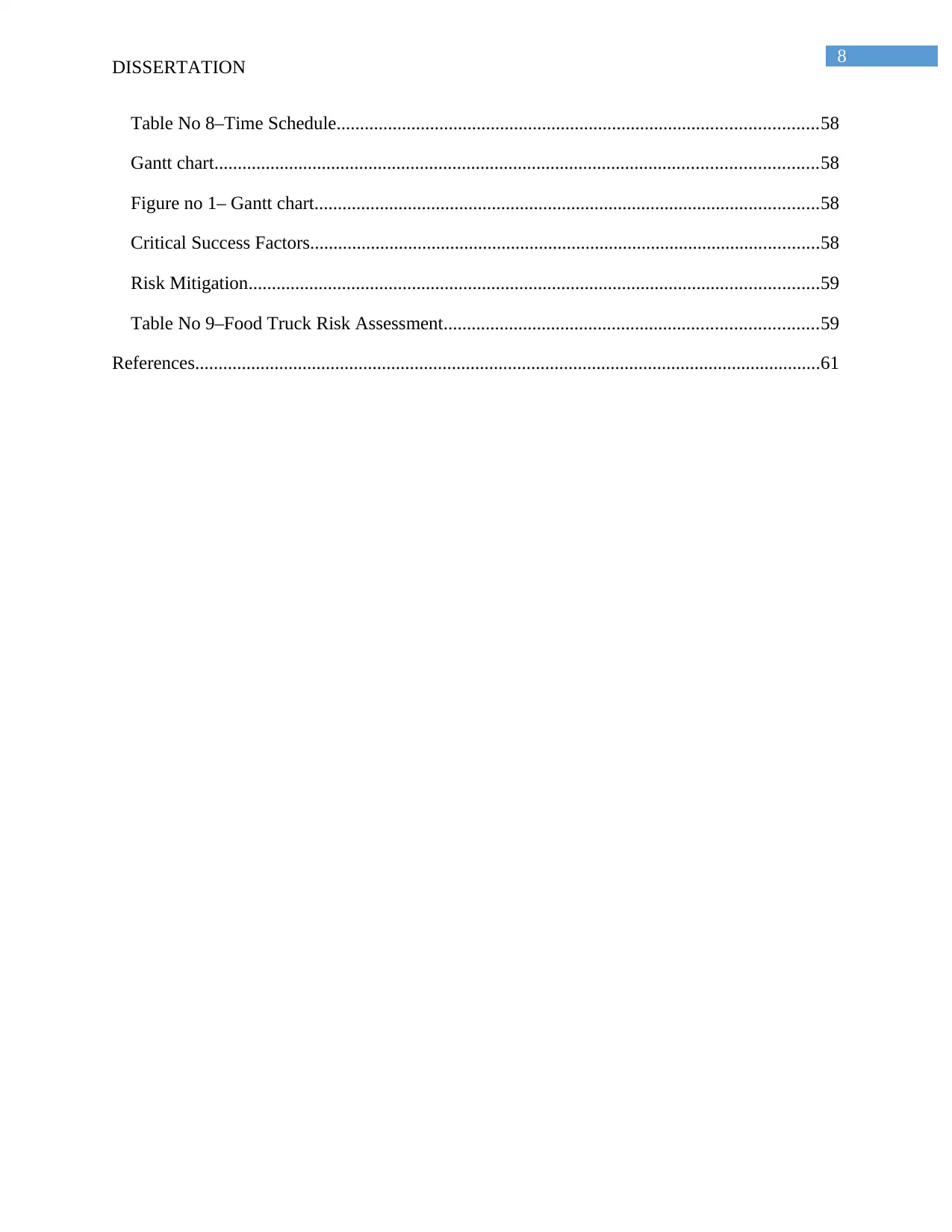
8
DISSERTATION
Table No 8–Time Schedule.......................................................................................................58
Gantt chart.................................................................................................................................58
Figure no 1– Gantt chart............................................................................................................58
Critical Success Factors.............................................................................................................58
Risk Mitigation..........................................................................................................................59
Table No 9–Food Truck Risk Assessment................................................................................59
References......................................................................................................................................61
DISSERTATION
Table No 8–Time Schedule.......................................................................................................58
Gantt chart.................................................................................................................................58
Figure no 1– Gantt chart............................................................................................................58
Critical Success Factors.............................................................................................................58
Risk Mitigation..........................................................................................................................59
Table No 9–Food Truck Risk Assessment................................................................................59
References......................................................................................................................................61
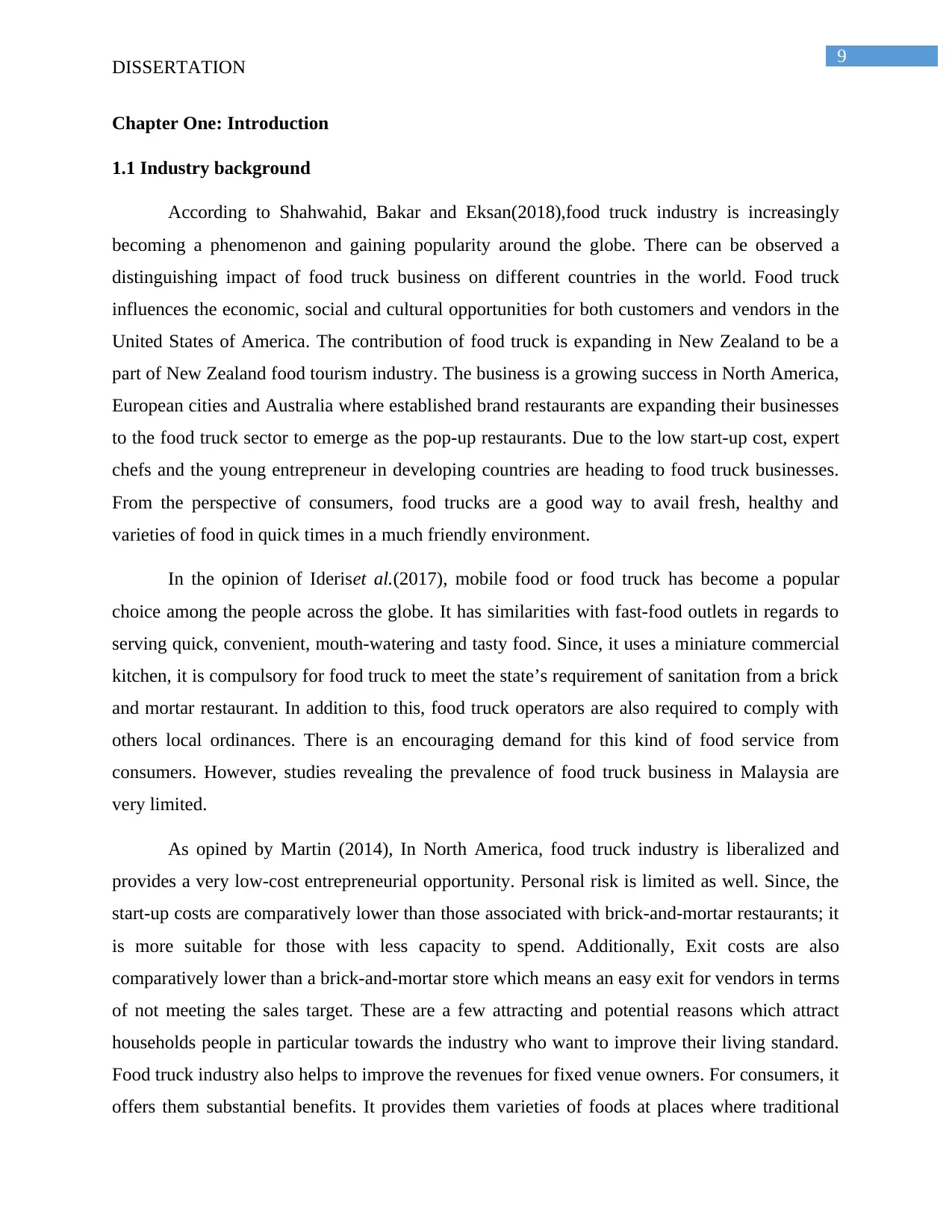
9
DISSERTATION
Chapter One: Introduction
1.1 Industry background
According to Shahwahid, Bakar and Eksan(2018),food truck industry is increasingly
becoming a phenomenon and gaining popularity around the globe. There can be observed a
distinguishing impact of food truck business on different countries in the world. Food truck
influences the economic, social and cultural opportunities for both customers and vendors in the
United States of America. The contribution of food truck is expanding in New Zealand to be a
part of New Zealand food tourism industry. The business is a growing success in North America,
European cities and Australia where established brand restaurants are expanding their businesses
to the food truck sector to emerge as the pop-up restaurants. Due to the low start-up cost, expert
chefs and the young entrepreneur in developing countries are heading to food truck businesses.
From the perspective of consumers, food trucks are a good way to avail fresh, healthy and
varieties of food in quick times in a much friendly environment.
In the opinion of Ideriset al.(2017), mobile food or food truck has become a popular
choice among the people across the globe. It has similarities with fast-food outlets in regards to
serving quick, convenient, mouth-watering and tasty food. Since, it uses a miniature commercial
kitchen, it is compulsory for food truck to meet the state’s requirement of sanitation from a brick
and mortar restaurant. In addition to this, food truck operators are also required to comply with
others local ordinances. There is an encouraging demand for this kind of food service from
consumers. However, studies revealing the prevalence of food truck business in Malaysia are
very limited.
As opined by Martin (2014), In North America, food truck industry is liberalized and
provides a very low-cost entrepreneurial opportunity. Personal risk is limited as well. Since, the
start-up costs are comparatively lower than those associated with brick-and-mortar restaurants; it
is more suitable for those with less capacity to spend. Additionally, Exit costs are also
comparatively lower than a brick-and-mortar store which means an easy exit for vendors in terms
of not meeting the sales target. These are a few attracting and potential reasons which attract
households people in particular towards the industry who want to improve their living standard.
Food truck industry also helps to improve the revenues for fixed venue owners. For consumers, it
offers them substantial benefits. It provides them varieties of foods at places where traditional
DISSERTATION
Chapter One: Introduction
1.1 Industry background
According to Shahwahid, Bakar and Eksan(2018),food truck industry is increasingly
becoming a phenomenon and gaining popularity around the globe. There can be observed a
distinguishing impact of food truck business on different countries in the world. Food truck
influences the economic, social and cultural opportunities for both customers and vendors in the
United States of America. The contribution of food truck is expanding in New Zealand to be a
part of New Zealand food tourism industry. The business is a growing success in North America,
European cities and Australia where established brand restaurants are expanding their businesses
to the food truck sector to emerge as the pop-up restaurants. Due to the low start-up cost, expert
chefs and the young entrepreneur in developing countries are heading to food truck businesses.
From the perspective of consumers, food trucks are a good way to avail fresh, healthy and
varieties of food in quick times in a much friendly environment.
In the opinion of Ideriset al.(2017), mobile food or food truck has become a popular
choice among the people across the globe. It has similarities with fast-food outlets in regards to
serving quick, convenient, mouth-watering and tasty food. Since, it uses a miniature commercial
kitchen, it is compulsory for food truck to meet the state’s requirement of sanitation from a brick
and mortar restaurant. In addition to this, food truck operators are also required to comply with
others local ordinances. There is an encouraging demand for this kind of food service from
consumers. However, studies revealing the prevalence of food truck business in Malaysia are
very limited.
As opined by Martin (2014), In North America, food truck industry is liberalized and
provides a very low-cost entrepreneurial opportunity. Personal risk is limited as well. Since, the
start-up costs are comparatively lower than those associated with brick-and-mortar restaurants; it
is more suitable for those with less capacity to spend. Additionally, Exit costs are also
comparatively lower than a brick-and-mortar store which means an easy exit for vendors in terms
of not meeting the sales target. These are a few attracting and potential reasons which attract
households people in particular towards the industry who want to improve their living standard.
Food truck industry also helps to improve the revenues for fixed venue owners. For consumers, it
offers them substantial benefits. It provides them varieties of foods at places where traditional
⊘ This is a preview!⊘
Do you want full access?
Subscribe today to unlock all pages.

Trusted by 1+ million students worldwide
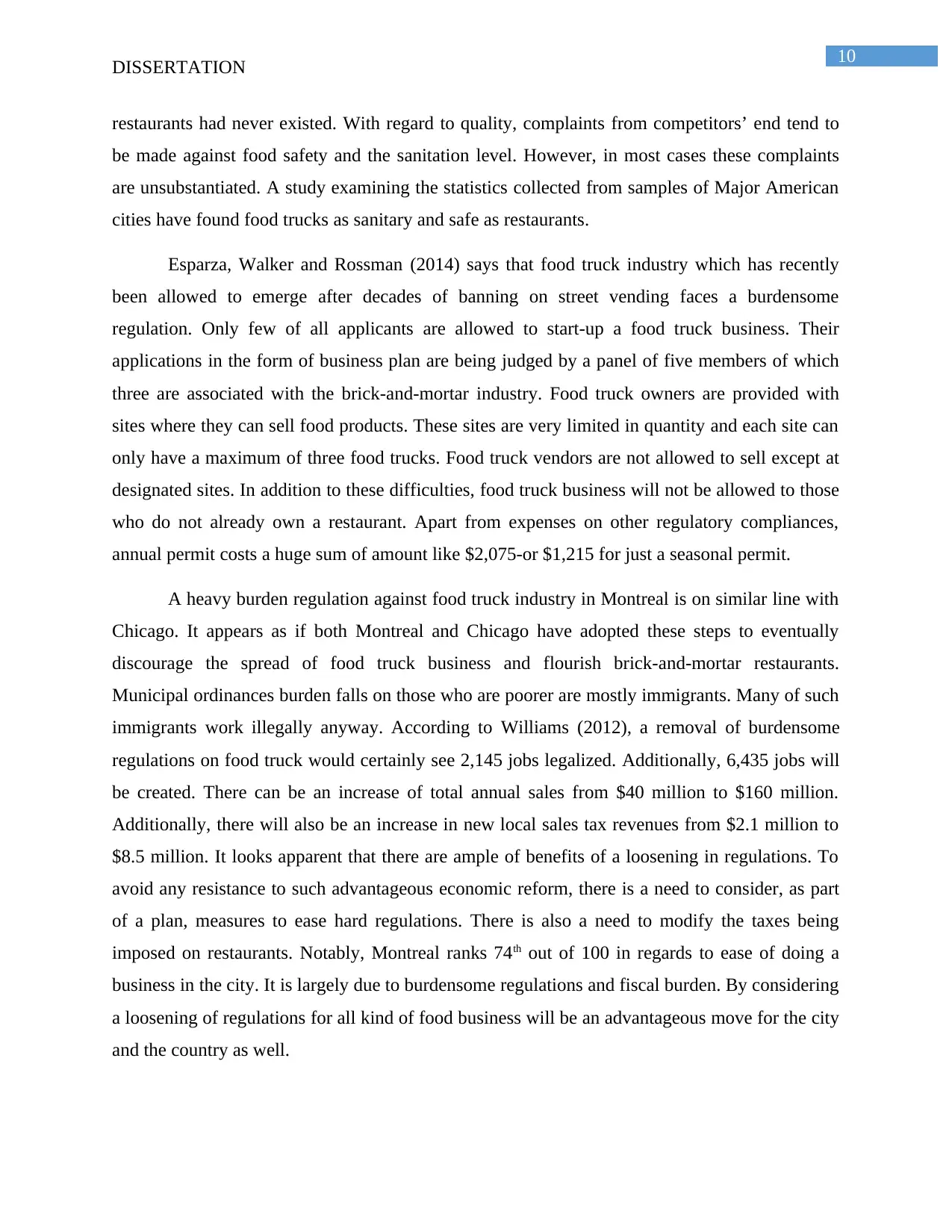
10
DISSERTATION
restaurants had never existed. With regard to quality, complaints from competitors’ end tend to
be made against food safety and the sanitation level. However, in most cases these complaints
are unsubstantiated. A study examining the statistics collected from samples of Major American
cities have found food trucks as sanitary and safe as restaurants.
Esparza, Walker and Rossman (2014) says that food truck industry which has recently
been allowed to emerge after decades of banning on street vending faces a burdensome
regulation. Only few of all applicants are allowed to start-up a food truck business. Their
applications in the form of business plan are being judged by a panel of five members of which
three are associated with the brick-and-mortar industry. Food truck owners are provided with
sites where they can sell food products. These sites are very limited in quantity and each site can
only have a maximum of three food trucks. Food truck vendors are not allowed to sell except at
designated sites. In addition to these difficulties, food truck business will not be allowed to those
who do not already own a restaurant. Apart from expenses on other regulatory compliances,
annual permit costs a huge sum of amount like $2,075-or $1,215 for just a seasonal permit.
A heavy burden regulation against food truck industry in Montreal is on similar line with
Chicago. It appears as if both Montreal and Chicago have adopted these steps to eventually
discourage the spread of food truck business and flourish brick-and-mortar restaurants.
Municipal ordinances burden falls on those who are poorer are mostly immigrants. Many of such
immigrants work illegally anyway. According to Williams (2012), a removal of burdensome
regulations on food truck would certainly see 2,145 jobs legalized. Additionally, 6,435 jobs will
be created. There can be an increase of total annual sales from $40 million to $160 million.
Additionally, there will also be an increase in new local sales tax revenues from $2.1 million to
$8.5 million. It looks apparent that there are ample of benefits of a loosening in regulations. To
avoid any resistance to such advantageous economic reform, there is a need to consider, as part
of a plan, measures to ease hard regulations. There is also a need to modify the taxes being
imposed on restaurants. Notably, Montreal ranks 74th out of 100 in regards to ease of doing a
business in the city. It is largely due to burdensome regulations and fiscal burden. By considering
a loosening of regulations for all kind of food business will be an advantageous move for the city
and the country as well.
DISSERTATION
restaurants had never existed. With regard to quality, complaints from competitors’ end tend to
be made against food safety and the sanitation level. However, in most cases these complaints
are unsubstantiated. A study examining the statistics collected from samples of Major American
cities have found food trucks as sanitary and safe as restaurants.
Esparza, Walker and Rossman (2014) says that food truck industry which has recently
been allowed to emerge after decades of banning on street vending faces a burdensome
regulation. Only few of all applicants are allowed to start-up a food truck business. Their
applications in the form of business plan are being judged by a panel of five members of which
three are associated with the brick-and-mortar industry. Food truck owners are provided with
sites where they can sell food products. These sites are very limited in quantity and each site can
only have a maximum of three food trucks. Food truck vendors are not allowed to sell except at
designated sites. In addition to these difficulties, food truck business will not be allowed to those
who do not already own a restaurant. Apart from expenses on other regulatory compliances,
annual permit costs a huge sum of amount like $2,075-or $1,215 for just a seasonal permit.
A heavy burden regulation against food truck industry in Montreal is on similar line with
Chicago. It appears as if both Montreal and Chicago have adopted these steps to eventually
discourage the spread of food truck business and flourish brick-and-mortar restaurants.
Municipal ordinances burden falls on those who are poorer are mostly immigrants. Many of such
immigrants work illegally anyway. According to Williams (2012), a removal of burdensome
regulations on food truck would certainly see 2,145 jobs legalized. Additionally, 6,435 jobs will
be created. There can be an increase of total annual sales from $40 million to $160 million.
Additionally, there will also be an increase in new local sales tax revenues from $2.1 million to
$8.5 million. It looks apparent that there are ample of benefits of a loosening in regulations. To
avoid any resistance to such advantageous economic reform, there is a need to consider, as part
of a plan, measures to ease hard regulations. There is also a need to modify the taxes being
imposed on restaurants. Notably, Montreal ranks 74th out of 100 in regards to ease of doing a
business in the city. It is largely due to burdensome regulations and fiscal burden. By considering
a loosening of regulations for all kind of food business will be an advantageous move for the city
and the country as well.
Paraphrase This Document
Need a fresh take? Get an instant paraphrase of this document with our AI Paraphraser
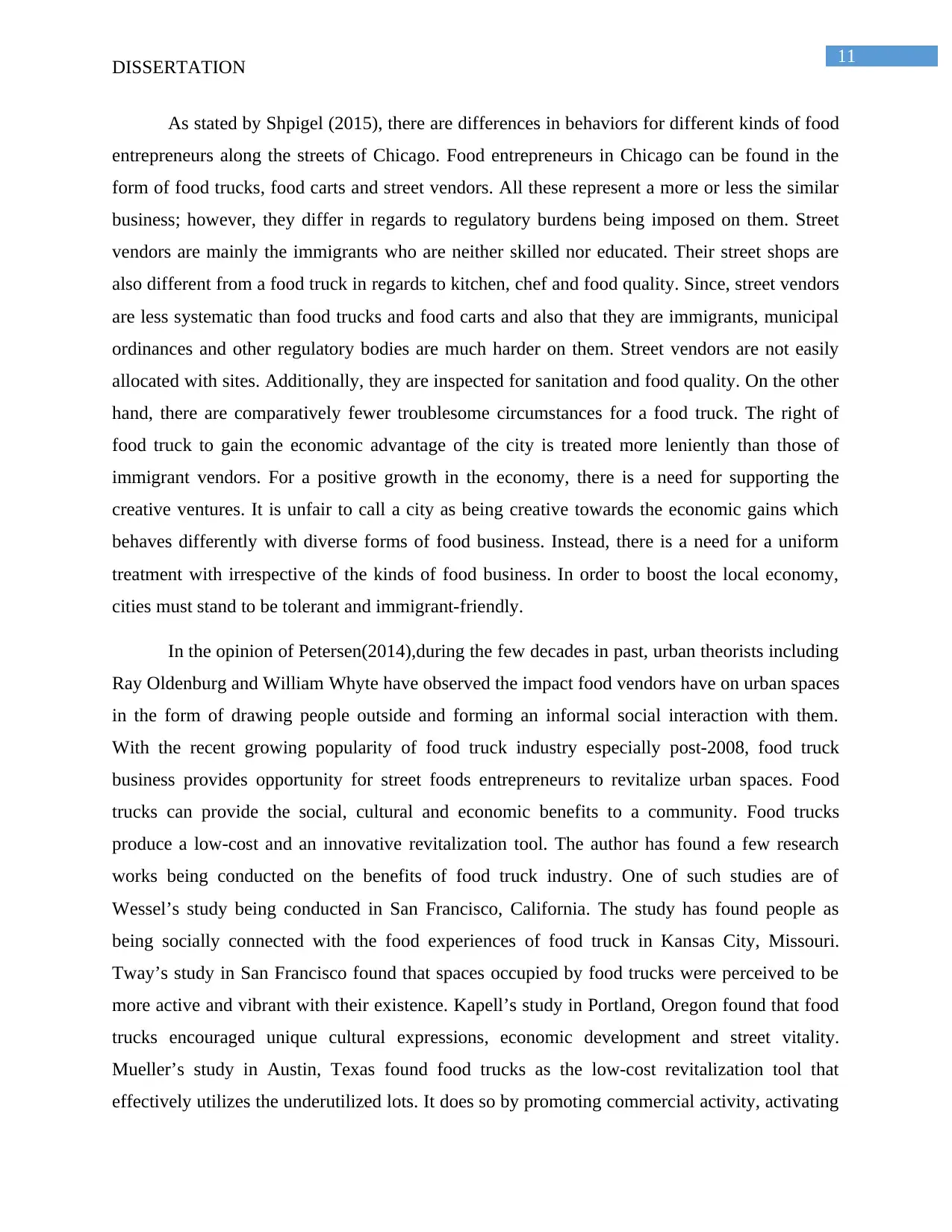
11
DISSERTATION
As stated by Shpigel (2015), there are differences in behaviors for different kinds of food
entrepreneurs along the streets of Chicago. Food entrepreneurs in Chicago can be found in the
form of food trucks, food carts and street vendors. All these represent a more or less the similar
business; however, they differ in regards to regulatory burdens being imposed on them. Street
vendors are mainly the immigrants who are neither skilled nor educated. Their street shops are
also different from a food truck in regards to kitchen, chef and food quality. Since, street vendors
are less systematic than food trucks and food carts and also that they are immigrants, municipal
ordinances and other regulatory bodies are much harder on them. Street vendors are not easily
allocated with sites. Additionally, they are inspected for sanitation and food quality. On the other
hand, there are comparatively fewer troublesome circumstances for a food truck. The right of
food truck to gain the economic advantage of the city is treated more leniently than those of
immigrant vendors. For a positive growth in the economy, there is a need for supporting the
creative ventures. It is unfair to call a city as being creative towards the economic gains which
behaves differently with diverse forms of food business. Instead, there is a need for a uniform
treatment with irrespective of the kinds of food business. In order to boost the local economy,
cities must stand to be tolerant and immigrant-friendly.
In the opinion of Petersen(2014),during the few decades in past, urban theorists including
Ray Oldenburg and William Whyte have observed the impact food vendors have on urban spaces
in the form of drawing people outside and forming an informal social interaction with them.
With the recent growing popularity of food truck industry especially post-2008, food truck
business provides opportunity for street foods entrepreneurs to revitalize urban spaces. Food
trucks can provide the social, cultural and economic benefits to a community. Food trucks
produce a low-cost and an innovative revitalization tool. The author has found a few research
works being conducted on the benefits of food truck industry. One of such studies are of
Wessel’s study being conducted in San Francisco, California. The study has found people as
being socially connected with the food experiences of food truck in Kansas City, Missouri.
Tway’s study in San Francisco found that spaces occupied by food trucks were perceived to be
more active and vibrant with their existence. Kapell’s study in Portland, Oregon found that food
trucks encouraged unique cultural expressions, economic development and street vitality.
Mueller’s study in Austin, Texas found food trucks as the low-cost revitalization tool that
effectively utilizes the underutilized lots. It does so by promoting commercial activity, activating
DISSERTATION
As stated by Shpigel (2015), there are differences in behaviors for different kinds of food
entrepreneurs along the streets of Chicago. Food entrepreneurs in Chicago can be found in the
form of food trucks, food carts and street vendors. All these represent a more or less the similar
business; however, they differ in regards to regulatory burdens being imposed on them. Street
vendors are mainly the immigrants who are neither skilled nor educated. Their street shops are
also different from a food truck in regards to kitchen, chef and food quality. Since, street vendors
are less systematic than food trucks and food carts and also that they are immigrants, municipal
ordinances and other regulatory bodies are much harder on them. Street vendors are not easily
allocated with sites. Additionally, they are inspected for sanitation and food quality. On the other
hand, there are comparatively fewer troublesome circumstances for a food truck. The right of
food truck to gain the economic advantage of the city is treated more leniently than those of
immigrant vendors. For a positive growth in the economy, there is a need for supporting the
creative ventures. It is unfair to call a city as being creative towards the economic gains which
behaves differently with diverse forms of food business. Instead, there is a need for a uniform
treatment with irrespective of the kinds of food business. In order to boost the local economy,
cities must stand to be tolerant and immigrant-friendly.
In the opinion of Petersen(2014),during the few decades in past, urban theorists including
Ray Oldenburg and William Whyte have observed the impact food vendors have on urban spaces
in the form of drawing people outside and forming an informal social interaction with them.
With the recent growing popularity of food truck industry especially post-2008, food truck
business provides opportunity for street foods entrepreneurs to revitalize urban spaces. Food
trucks can provide the social, cultural and economic benefits to a community. Food trucks
produce a low-cost and an innovative revitalization tool. The author has found a few research
works being conducted on the benefits of food truck industry. One of such studies are of
Wessel’s study being conducted in San Francisco, California. The study has found people as
being socially connected with the food experiences of food truck in Kansas City, Missouri.
Tway’s study in San Francisco found that spaces occupied by food trucks were perceived to be
more active and vibrant with their existence. Kapell’s study in Portland, Oregon found that food
trucks encouraged unique cultural expressions, economic development and street vitality.
Mueller’s study in Austin, Texas found food trucks as the low-cost revitalization tool that
effectively utilizes the underutilized lots. It does so by promoting commercial activity, activating
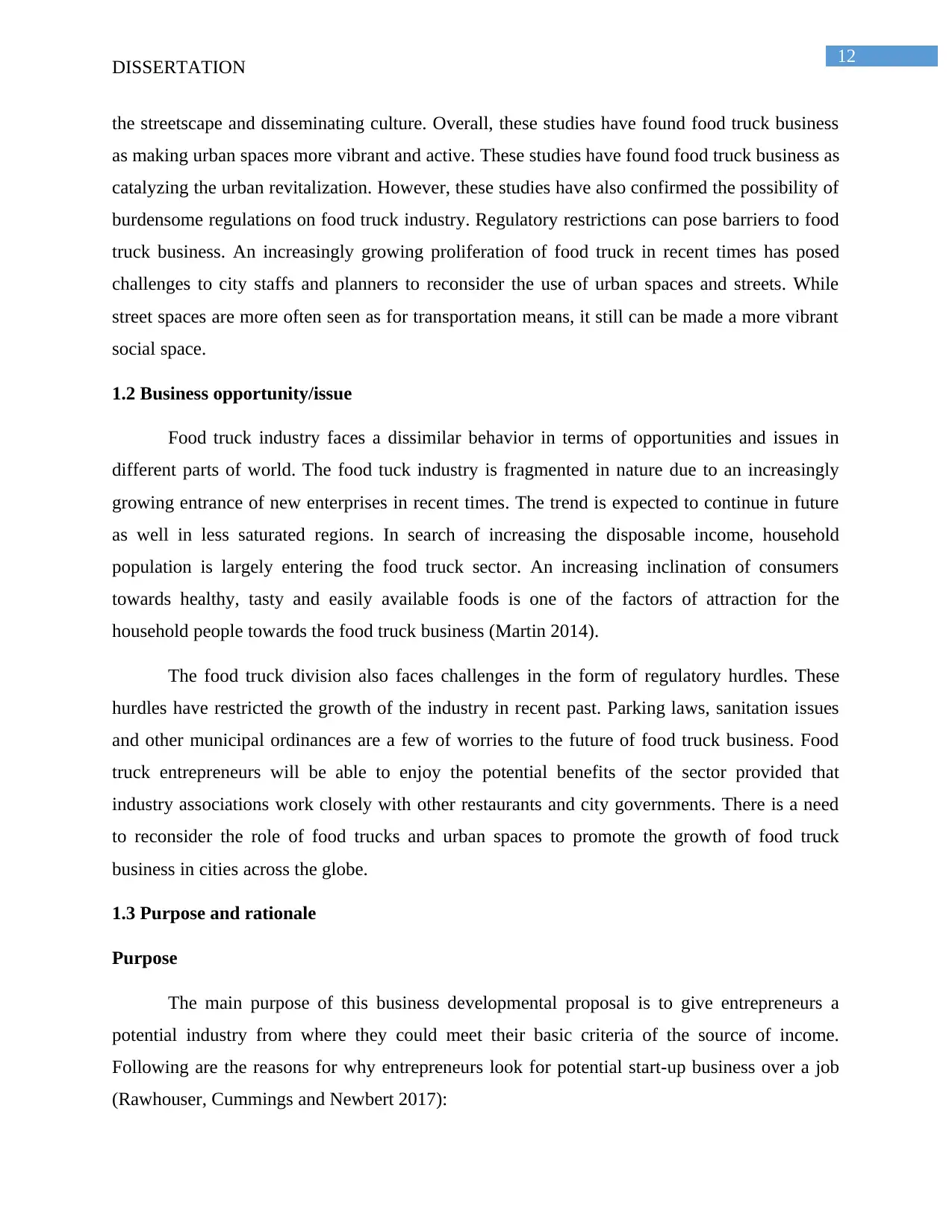
12
DISSERTATION
the streetscape and disseminating culture. Overall, these studies have found food truck business
as making urban spaces more vibrant and active. These studies have found food truck business as
catalyzing the urban revitalization. However, these studies have also confirmed the possibility of
burdensome regulations on food truck industry. Regulatory restrictions can pose barriers to food
truck business. An increasingly growing proliferation of food truck in recent times has posed
challenges to city staffs and planners to reconsider the use of urban spaces and streets. While
street spaces are more often seen as for transportation means, it still can be made a more vibrant
social space.
1.2 Business opportunity/issue
Food truck industry faces a dissimilar behavior in terms of opportunities and issues in
different parts of world. The food tuck industry is fragmented in nature due to an increasingly
growing entrance of new enterprises in recent times. The trend is expected to continue in future
as well in less saturated regions. In search of increasing the disposable income, household
population is largely entering the food truck sector. An increasing inclination of consumers
towards healthy, tasty and easily available foods is one of the factors of attraction for the
household people towards the food truck business (Martin 2014).
The food truck division also faces challenges in the form of regulatory hurdles. These
hurdles have restricted the growth of the industry in recent past. Parking laws, sanitation issues
and other municipal ordinances are a few of worries to the future of food truck business. Food
truck entrepreneurs will be able to enjoy the potential benefits of the sector provided that
industry associations work closely with other restaurants and city governments. There is a need
to reconsider the role of food trucks and urban spaces to promote the growth of food truck
business in cities across the globe.
1.3 Purpose and rationale
Purpose
The main purpose of this business developmental proposal is to give entrepreneurs a
potential industry from where they could meet their basic criteria of the source of income.
Following are the reasons for why entrepreneurs look for potential start-up business over a job
(Rawhouser, Cummings and Newbert 2017):
DISSERTATION
the streetscape and disseminating culture. Overall, these studies have found food truck business
as making urban spaces more vibrant and active. These studies have found food truck business as
catalyzing the urban revitalization. However, these studies have also confirmed the possibility of
burdensome regulations on food truck industry. Regulatory restrictions can pose barriers to food
truck business. An increasingly growing proliferation of food truck in recent times has posed
challenges to city staffs and planners to reconsider the use of urban spaces and streets. While
street spaces are more often seen as for transportation means, it still can be made a more vibrant
social space.
1.2 Business opportunity/issue
Food truck industry faces a dissimilar behavior in terms of opportunities and issues in
different parts of world. The food tuck industry is fragmented in nature due to an increasingly
growing entrance of new enterprises in recent times. The trend is expected to continue in future
as well in less saturated regions. In search of increasing the disposable income, household
population is largely entering the food truck sector. An increasing inclination of consumers
towards healthy, tasty and easily available foods is one of the factors of attraction for the
household people towards the food truck business (Martin 2014).
The food truck division also faces challenges in the form of regulatory hurdles. These
hurdles have restricted the growth of the industry in recent past. Parking laws, sanitation issues
and other municipal ordinances are a few of worries to the future of food truck business. Food
truck entrepreneurs will be able to enjoy the potential benefits of the sector provided that
industry associations work closely with other restaurants and city governments. There is a need
to reconsider the role of food trucks and urban spaces to promote the growth of food truck
business in cities across the globe.
1.3 Purpose and rationale
Purpose
The main purpose of this business developmental proposal is to give entrepreneurs a
potential industry from where they could meet their basic criteria of the source of income.
Following are the reasons for why entrepreneurs look for potential start-up business over a job
(Rawhouser, Cummings and Newbert 2017):
⊘ This is a preview!⊘
Do you want full access?
Subscribe today to unlock all pages.

Trusted by 1+ million students worldwide
1 out of 66
Related Documents
Your All-in-One AI-Powered Toolkit for Academic Success.
+13062052269
info@desklib.com
Available 24*7 on WhatsApp / Email
![[object Object]](/_next/static/media/star-bottom.7253800d.svg)
Unlock your academic potential
Copyright © 2020–2025 A2Z Services. All Rights Reserved. Developed and managed by ZUCOL.



